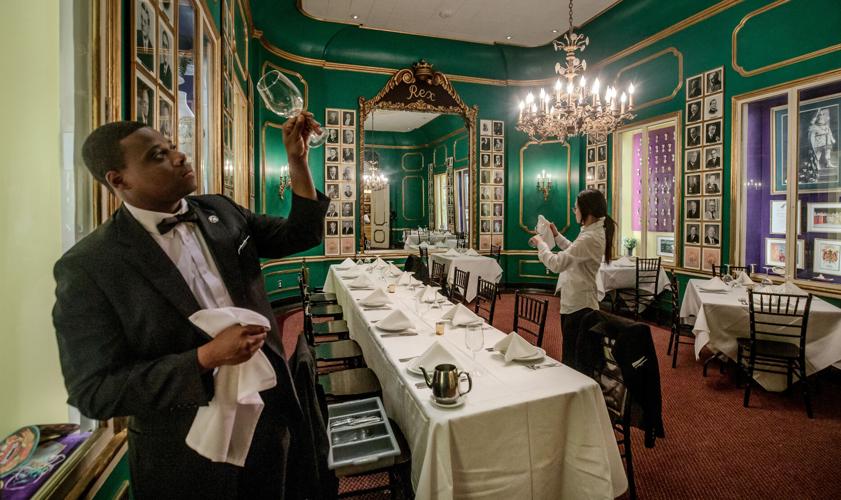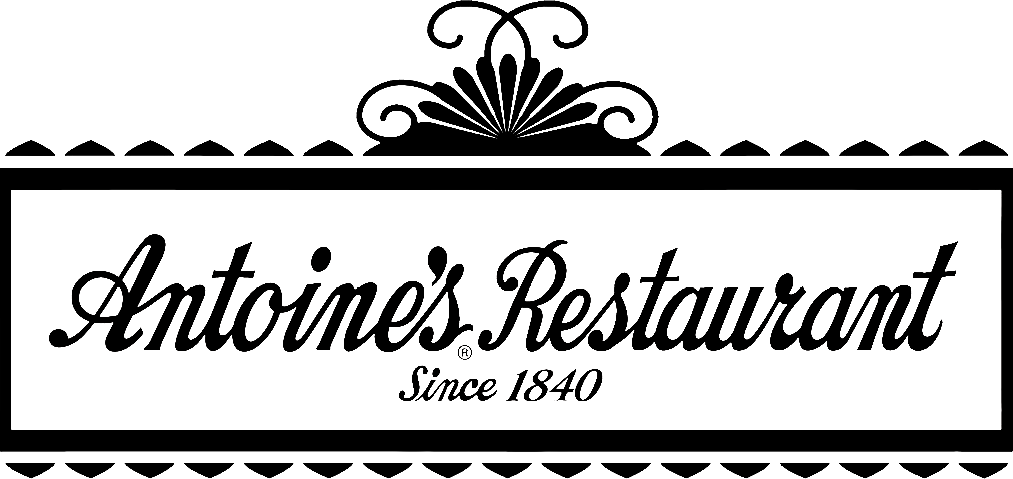At Antoine’s, New Orleans’ oldest restaurant, change keeps coming to keep tradition alive

By Ian McNulty | Staff Writer
As an early weeknight dinner got underway at Antoine’s, the low-lit, garnet-red dining room at the center of the landmark French Quarter restaurant looked like a vignette from the past.
However, just through the slapping doors to the kitchen, there’s a story of change and evolution in the name of preservation.
In the balance is the continuation of a famous restaurant that is deeply entwined with the family histories, social rituals and culinary traditions of New Orleans.
Antoine’s kitchen was bustling that night. Under thick wooden beams high above, cooks swept past with trays of steaks, piped meringue onto regal baked Alaska desserts and tended plates of oyster Rockefeller in a broiler that dates to the Truman administration.
But they were also using new computer systems to help manage their output between the private parties and individual diners they’re simultaneously serving across many dining rooms. And new dishes, like Wagyu steak with foie gras and redfish cooked skin-on (or “on the half shell”), were being tested for flavor and presentation next to the steady flow of Antoine’s classics.
At the helm now is Mark Quitney, a veteran of local hotel kitchens who became Antoine’s executive chef this summer.
The seas he’s navigating here are cut by two currents.
As a historic restaurant, Antoine’s must maintain traditions cherished by its most ardent loyalists, and which draw visitors for bucket-list dinners.
But it also must remain viable in a time of ever-shifting trends and tastes and manage a business environment that’s grown more challenging for restaurants, with prices up across the board and new competition constantly emerging.
“You have to be able to move the needle forward and also hold on to the tradition and share that history with people,” Quitney said, while toggling between tasks in the kitchen. “That history resonates. You can feel it here.”
The new chef is entering his first holiday season at Antoine’s, a crucial period for the restaurant’s bottom line and one that vividly displays its cultural significance in New Orleans.
Starting the Friday after Thanksgiving and extending through New Year’s, a restaurant that rambles over 14 dining rooms and can seat up to 1,100 people will fill with private holiday parties and family dinner outings large and small. The pace continues in Carnival season, reflecting the restaurant’s long-running role with Mardi Gras krewes.
These dinners and events often represent annual traditions that have been upheld for generations. They feed on the restaurant’s continuity and sense of timelessness, with tuxedo-clad waiters serving classic French Creole dishes, some of which were created here.
In truth, though, the restaurant has been changing at a rapidly increasing clip in recent years, and nowhere is this more evident than in the kitchen that supplies all those luncheons, dinners and parties.
“Isn’t that the irony? If you want to earn the right to keep a tradition, you have to change to preserve it,” said Rick Blount, the restaurant’s president and CEO.
Antoine’s is famously the oldest restaurant in New Orleans, dating to 1840. Perhaps lesser known is its status as the oldest restaurant in the United States continuously run by the same family, now in its fifth generation. The through line of family and tradition is direct.
Blount is the great-great-grandson of restaurant namesake Antoine Alciatore, who first opened Antoine’s as a single dining room in a boarding house 183 years ago, at a location a few blocks from the present address at 713 St. Louis St. (Antoine’s relocated here in 1868).
Today, Antoine’s wends over an indoor campus of interconnected buildings that account for some 50,000 square feet. It got there in piecemeal fashion through the generations.
“You would not open a restaurant like this today, no one would want to,” said Blount. “It’s too big, the complexities of its size are too much. You’d do what modern chefs do and build four smaller restaurants. I think if someone else were to buy Antoine’s, they’d cut it up.”
Blount will not do that, though.
“The traditions of New Orleans are much too important to me to consider that,” he said.
What is changing are the ways Blount and his wife Lisa, marketing director for Antoine’s, are finding to manage this immensity.
The changes are hardly radical, and many are standard at most restaurants. At Antoine’s, they add up to a sea change after doing business in one way for so long.
Not long ago, the standard practice for regulars to make a dinner reservation or even to plan a large event was to simply phone their favorite waiter, who took it from there. Now events go through Antoine’s dedicated private dining staff and the restaurant uses an online reservation system, a change that has brought a 20% rise in bookings.
Waiters also once transmitted orders to the kitchen by walking in and hollering out what they needed to the cooks. And waiters were often the ones garnishing dishes on the way back out to the dining room.
Now computer displays show cooks at the various stations what’s needed, and, crucially, there’s now a “pass,” the table where chefs finish and inspect dishes before waiters or dish runners take over. Modern steam kettles have replaced some of the giant pots once used for stocks and broths, which can hold them at temperature better.
“It’s about organizing around the traditions in ways that let us execute them better,” Lisa Blount said.
Between new gear and processes, though, Antoine’s kitchen remains the realm of veteran cooks and chefs who are keepers of the restaurant’s traditions.
One is Ernest “Skeeter” Jack, who started at Antoine’s right out of high school four decades ago washing dishes and eventually worked every station in the kitchen. Today he’s executive saucier, overseeing a cornerstone of Antoine’s cuisine, from the classic marchand de vin to the signature Rockefeller sauce, an Antoine’s creation much reinterpreted around the world.
“Sauces are the foundation of the menu. That’s where the tradition starts,” Jack said. “I do it the way the chefs here before me showed me, and I’m teaching the others coming up.”
That inter-generational exchange is key to making this kitchen work, said chef de cuisine Tyrone Hagan.
“A lot of what you know from other places, it doesn’t apply here,” Hagan said. “They don’t necessarily teach you the traditional dishes we do here.”
He urges new staff to watch and learn from the veterans around them and, especially as the holiday rush revs up, to tackle their tasks one step at a time.
“It could look chaotic in here, but really it’s a dance,” Hagan said. “And on the big nights, everybody has to be in sync.”
See the full story on nola.com: https://www.nola.com/entertainment_life/eat-drink/antoines-new-orleans-oldest-restaurant-has-new-chef/article_7e577de8-858f-11ee-8977-6795e1dae2d9.html
